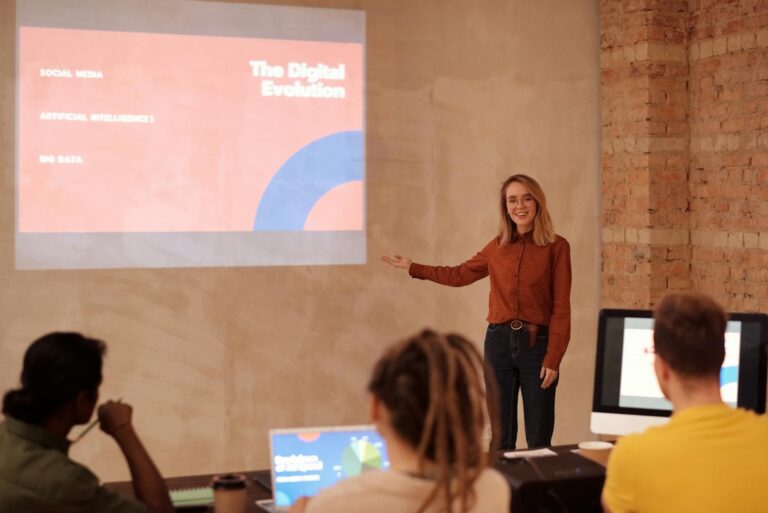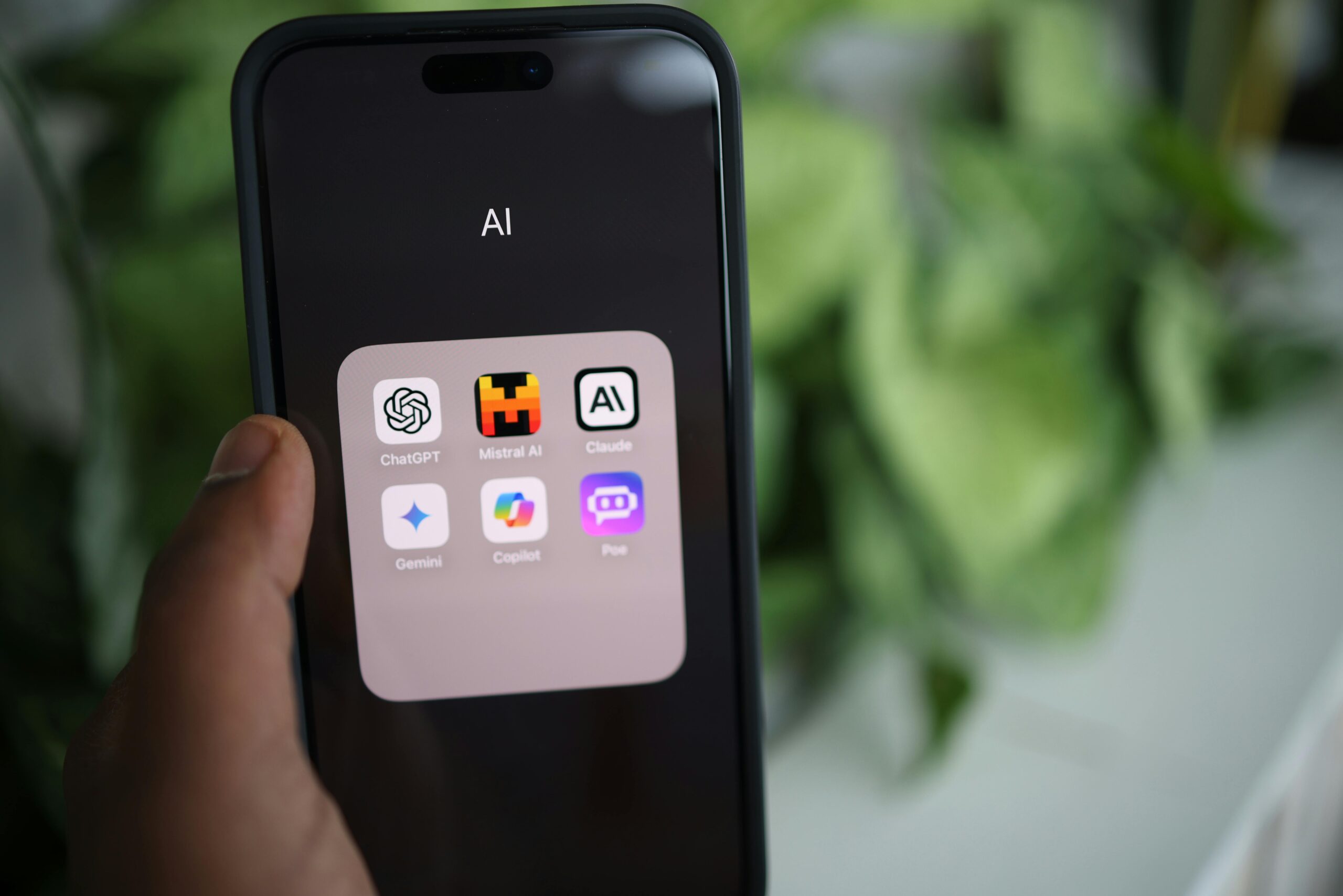2025 Tech Playbook Navigating Future Business Growth
The 2025 Tech Playbook: Navigating the Future of Web, Mobile, Cloud, AI, and UI/UX for Business Growth
Estimated reading time: 16 minutes
Key Takeaways
- The digital landscape in 2025 emphasizes hyper-personalization, AI integration, and seamless user experiences across web, mobile, and cloud platforms.
- AI automation is critical for business growth, focusing on intelligent delegation, workflow optimization, and enhancing productivity, as supported by specialists like AITechScope.
- Modern tech stacks prioritize flexibility, scalability, and security, utilizing cloud-native architectures, serverless solutions, and robust DevOps practices for efficiency.
- UI/UX design in 2025 centers on intuition, accessibility, and immersive interfaces, moving beyond mobile-first to adapt to diverse devices and user contexts.
- Small businesses and startups can leverage these advanced technologies on a budget through strategic adoption of cloud services, open-source tools, and AI automation to build future-proof tech stacks.
Table of Contents
- The 2025 Tech Playbook: Navigating the Future of Web, Mobile, Cloud, AI, and UI/UX for Business Growth
- The Shifting Sands of 2025: A New Digital Paradigm
- Web Development in 2025: Building the Hyper-Personalized, Lightning-Fast Web
- Mobile App Innovation in 2025: Seamless Experiences, Cross-Platform Power
- Cloud Computing & DevOps in 2025: Efficiency, Automation, and Scalability
- AI Automation for Businesses in 2025: Intelligent Delegation and Growth
- Modern UI/UX Design in 2025: Crafting Intuitive, Accessible, and Engaging Experiences
- Digital Transformation for Small Businesses & Startups: Navigating the Future
- Conclusion: Embracing the Future of Tech with AITechScope
- FAQs (Frequently Asked Questions)
- Q1: What are the most significant 2025 tech trends for small businesses?
- Q2: How will AI automation impact businesses in 2025?
- Q3: Which mobile framework should startups choose in 2025: Flutter or React Native?
- Q4: What are the main benefits of serverless architecture for startups?
- Q5: How can businesses ensure their web development is future-proof in 2025?
The 2025 Tech Playbook: Navigating the Future of Web, Mobile, Cloud, AI, and UI/UX for Business Growth
The digital landscape is a relentless current, constantly shifting and evolving. For businesses and tech enthusiasts alike, staying ahead of the curve isn’t just an advantage—it’s a necessity for survival and growth. As we hurtle towards 2025, the pace of innovation is accelerating, fueled by advancements that promise to redefine how we interact with technology, run our businesses, and connect with customers. From hyper-intelligent AI to seamlessly integrated digital experiences, the coming years will usher in an era of unprecedented opportunities and challenges.
This comprehensive guide serves as your definitive "2025 Tech Playbook," breaking down the most impactful trends across web development, mobile app innovation, cloud computing, DevOps, AI automation for businesses, and modern UI/UX design. We’ll explore how these advancements are converging to create a new digital paradigm, offering actionable strategies for companies of all sizes to leverage cutting-edge tools and transform their operations. Whether you’re a startup seeking a competitive edge or an established enterprise planning your next digital transformation strategy, understanding these trends is the first step towards building a future-proof tech stack. Join us as we uncover how today’s tech can accelerate growth, improve performance, and redefine the way companies operate, powered by insights into intelligent delegation and automation solutions from specialists like AITechScope.
The Shifting Sands of 2025: A New Digital Paradigm
The year 2025 marks a pivotal moment in technology, where the lines between various disciplines blur, creating a holistic digital experience. Digital transformation is no longer a luxury but a fundamental requirement for survival, driven by rapidly changing consumer expectations and technological capabilities.
Digital Transformation: Beyond Buzzwords, Towards Actionable Strategies
Digital transformation strategies in 2025 are less about adopting new tools and more about fundamentally reimagining business processes, customer interactions, and operational efficiency. For small businesses and large enterprises alike, this means embracing agile methodologies, fostering a culture of continuous innovation, and strategically integrating technology into every facet of the organization. The goal is to create responsive, resilient, and adaptive systems that can quickly pivot in an ever-changing market. This often involves migrating legacy systems to modern cloud infrastructures, automating repetitive tasks, and leveraging data for informed decision-making. "Digital Transformation on a Budget: 7 Steps Small Companies Can Start Today" highlights the accessibility of these strategies, proving that impactful change doesn’t always require immense capital.
The Core Pillars of Modern Tech Stacks for 2025
The ideal tech stack for modern businesses in 2025 is characterized by flexibility, scalability, and intelligence. It’s a blend of robust backend infrastructure, dynamic front-end frameworks, intelligent automation layers, and intuitive user interfaces. Key components include:
- Cloud-Native Architectures: Prioritizing serverless and microservices for agility.
- AI/ML Integration: Embedding intelligence across applications and workflows.
- Headless Commerce/CMS: Decoupling front-end from backend for ultimate flexibility.
- Performance Optimization: Focusing on speed and efficiency for superior user experience.
- Security by Design: Building robust security measures into every layer.
These pillars collectively support the next generation of digital products and services, emphasizing not just functionality, but also performance, user experience, and long-term maintainability.
Web Development in 2025: Building the Hyper-Personalized, Lightning-Fast Web
Web development in 2025 is no longer just about presenting information; it’s about crafting immersive, highly personalized, and blazingly fast experiences. The focus has decisively shifted towards performance, user engagement, and intelligent interactivity.
The Rise of AI-Powered Web Experiences
AI-powered web apps are moving from novelty to necessity. In 2025, AI is embedded in various aspects of web development, from intelligent content recommendations and personalized user journeys to predictive analytics that anticipate user needs. AI can optimize website layouts in real-time based on user behavior, automate A/B testing, and even generate dynamic content. This level of personalization significantly enhances user engagement and conversion rates, making the web experience feel tailor-made for each individual. AITechScope’s expertise in AI-powered automation is particularly relevant here, enabling businesses to integrate sophisticated AI features without extensive in-house development.
Next.js and React: Performance, Scalability, and Developer Experience
Next.js and React remain at the forefront of modern web development, continuously evolving to meet the demands of performance-critical applications. Their focus on server-side rendering (SSR), static site generation (SSG), and incremental static regeneration (ISR) provides unparalleled speed and SEO benefits. In 2025, these frameworks are integral to building enterprise-grade applications and small business sites alike, offering both powerful features and a streamlined developer experience.
Next.js for Small Businesses: Speed and Simplicity
For small businesses, "Next.js for Small Businesses: Build a Fast Marketing Site in One Weekend" is a testament to its efficiency. Next.js offers an excellent balance of power and simplicity, making it ideal for creating fast marketing sites, e-commerce platforms, and content-rich blogs. Its built-in optimization features, like image optimization and code splitting, ensure quick loading times—a crucial factor for user retention and SEO ranking. This allows small businesses to deploy professional, high-performance websites without requiring extensive development resources.
Mastering React Performance: Key Optimization Techniques
Even with powerful frameworks, performance optimization techniques are key. "5 Simple React Performance Fixes That Reduce Page Load by Seconds" highlights the continuous need for fine-tuning. Techniques like lazy loading components, memoization (React.memo, useCallback, useMemo), virtualized lists for large datasets, and efficient state management are critical for ensuring React applications remain responsive and fluid. Developers in 2025 will be expected to deeply understand these nuances to deliver truly outstanding user experiences.
Headless CMS and Micro-Frontends: Unlocking Agility
The trend towards headless CMS WordPress and other platforms continues to gain momentum. By decoupling the content management system from the front-end presentation layer, businesses gain immense flexibility. This architecture allows content to be delivered across multiple platforms (web, mobile, IoT) from a single source, enabling truly omnichannel experiences.
Microservices architecture, extended to the front-end as micro-frontends, further enhances agility. As discussed in "Micro Frontends: When They Help and When They Hurt (Practical Examples)," this approach allows large web applications to be broken into smaller, independently deployable units, speeding up development cycles and improving maintainability for complex projects.
Responsive and Adaptive UI Design: Beyond Mobile-First
While mobile-first design has been a staple, 2025 sees an evolution towards truly responsive UI design and adaptive experiences across an even wider array of devices, including wearables, smart displays, and immersive AR/VR environments. Designers must consider how content and interactions fluidly adapt not just to screen size, but also to user context, input methods, and even environmental factors. Accessibility remains paramount, with "Designing Accessible Buttons: A Non-Designer’s Guide (Figma Tips)" underscoring the importance of inclusive design practices from the outset.
Mobile App Innovation in 2025: Seamless Experiences, Cross-Platform Power
Mobile app development 2025 is characterized by seamless integration, hyper-personalization, and the ongoing quest for efficient cross-platform solutions. Apps are becoming more intelligent, anticipatory, and deeply embedded in our daily lives.
Flutter vs. React Native in 2025: The Battle for Cross-Platform Dominance
The debate of Flutter vs React Native in 2025 remains central for startups and enterprises looking to build efficient, high-performance mobile apps. Both frameworks offer significant advantages over native development, allowing code reuse across iOS and Android.
- Flutter: Known for its expressive UI and excellent performance, Flutter offers a native-like experience with a single codebase. Its "Build a Simple Cross-Platform App with Flutter: From Idea to Play Store" approach highlights its appeal for rapid development and beautiful designs.
- React Native: Backed by a large community and the familiarity of JavaScript/React, React Native offers strong ecosystem support and flexibility.
"React Native vs Flutter in 2025: Which Is Best for Your Business App?" concludes that the choice often depends on existing team expertise, specific UI requirements, and the desired level of native integration. Both will continue to dominate cross-platform development.
Choosing the Right Framework for Your Startup
For startups, the choice of which mobile framework for startups often comes down to balancing speed-to-market with long-term scalability and talent availability. Factors like budget, required native features, and the existing web development team’s skills play a crucial role. A lean startup might prioritize faster iteration with Flutter’s widget-based approach or leverage an existing React skillset with React Native.
Beyond the Screen: Integrating AI and IoT in Mobile Apps
Mobile app UI trends in 2025 extend beyond visual aesthetics to encompass deeper integrations. AI-powered mobile apps leverage device sensors, user behavior, and cloud intelligence to offer predictive functionalities, personalized alerts, and context-aware services. Imagine a health app that not only tracks your activity but also suggests personalized workouts based on your real-time fatigue levels and local weather, powered by IoT device data. This convergence creates highly intelligent and indispensable mobile experiences.
Intuitive Mobile UI Trends: Designing for the Future
Modern mobile app UI trends focus on minimalism, fluid animations, and intuitive gesture-based interactions. The goal is to reduce cognitive load and create delightful, almost invisible interfaces. Accessibility remains a non-negotiable aspect, ensuring apps are usable by everyone. Furthermore, with the rise of AI, mobile UI design is increasingly about facilitating seamless human-AI interaction, making complex AI features feel natural and easy to use.
Cloud Computing & DevOps in 2025: Efficiency, Automation, and Scalability
Cloud computing and DevOps continue to be foundational to modern software development, evolving towards greater automation, cost-efficiency, and resilience. In 2025, these practices are synonymous with agile development and operational excellence.
The Serverless Revolution: Cost-Efficiency and Elasticity
Serverless architecture is poised for even wider adoption in 2025. By abstracting away server management, developers can focus purely on code, leading to faster deployment cycles and significantly reduced operational overhead. Its pay-per-execution model makes it incredibly cost-efficient, especially for variable workloads.
Serverless AWS: A Cost-Effective Backend for Startups
For startups, "Serverless on AWS: Create a Cost-Efficient Backend That Scales Automatically" demonstrates the immense value of serverless AWS cost examples. Services like AWS Lambda, DynamoDB, and API Gateway provide a robust, scalable, and cost-effective backend for startups, allowing them to scale from zero to millions of users without incurring massive infrastructure costs. This empowers smaller teams to innovate rapidly without being bogged down by server provisioning and maintenance.
DevOps Best Practices and CI/CD Automation: Empowering Small Teams
DevOps best practices are no longer exclusive to large enterprises. CI/CD for small teams is becoming standard, enabling automated deployments without the headache. Continuous Integration (CI) and Continuous Delivery/Deployment (CD) pipelines automate the build, test, and deployment processes, drastically reducing manual errors and accelerating time-to-market.
GitHub Actions: Streamlining Deployments
GitHub Actions deploy tutorial showcases how even small teams can implement robust CI/CD automation. By leveraging cloud-based platforms and integrated tools, teams can set up automated workflows that trigger on every code commit, ensuring code quality and consistent deployments. This automation is crucial for maintaining developer velocity and ensuring that software development 2025 focuses on innovation rather than repetitive operational tasks.
Strategic Cloud Migration: Moving Legacy to the Future
Many businesses still grapple with legacy systems. In 2025, strategic cloud migration strategy becomes more refined, focusing on phased approaches and leveraging modern tools to minimize disruption. "How to Move Your Legacy App to the Cloud Without Breaking It" emphasizes careful planning, containerization, and often, a hybrid cloud approach as initial steps. The benefits—enhanced scalability, reduced costs, and improved disaster recovery—make cloud migration an imperative for long-term competitiveness.
AI Automation for Businesses in 2025: Intelligent Delegation and Growth
AI automation for businesses in 2025 is no longer a futuristic concept but a tangible reality transforming workforces and driving unprecedented efficiency. The MIT studies finding that AI can already do the work of 11.7% to 12% of America’s workforce (CBS News, Fast Company) underscore the profound impact of this technology. The focus shifts from fear of replacement to strategic augmentation and intelligent delegation.
AI-Powered Workflow Automation: Saving Time, Boosting Productivity
Workflow automation tools powered by AI are becoming indispensable. These tools can handle repetitive tasks, analyze complex data sets, and make autonomous decisions, freeing up human employees to focus on strategic, creative, and customer-facing activities. AITechScope specializes in n8n workflow development and business process optimization, helping companies leverage cutting-edge AI tools to scale operations, reduce costs, and improve efficiency through intelligent delegation and automation solutions. From automating data entry to managing complex sales pipelines, the possibilities are endless. "Automate Repetitive Tasks with No-Code Tools + AI (Save 5–10 Hours/Week)" illustrates the immediate benefits for businesses.
Chatbot Automation: Transforming Customer Service and Internal Workflows
AI chatbots for customer service are becoming more sophisticated, moving beyond simple FAQs to handle complex inquiries, provide personalized support, and even proactively engage customers. The Reuters report on how "AI reshapes shopping" highlights this trend, showing how retailers are using AI to change their online presence and customer interactions. "How Small Businesses Use Chatbots to Save Time: Real Workflows That Work" provides practical examples of how chatbot automation can significantly enhance customer satisfaction and operational efficiency, serving both external customers and internal teams.
SaaS Product Optimization with AI Features
SaaS product optimization in 2025 heavily relies on embedding AI features directly into applications. This could include AI-driven analytics that provide deeper insights, intelligent recommendations that guide users, or predictive maintenance features that anticipate potential issues. "Make Your SaaS Smarter: 3 Low-Effort AI Features That Delight Users" offers a practical guide for product managers looking to integrate AI seamlessly, enhancing user experience and product stickiness without extensive development overhead.
Addressing the Ethical Implications and Responsible AI Adoption
As AI becomes more pervasive, responsible AI adoption and addressing ethical implications are paramount. While incidents like the "ChatGPT firm blames boy’s suicide on ‘misuse’ of its technology" (The Guardian) serve as stark reminders of potential harms, they also highlight the critical need for ethical guidelines, robust safety measures, and transparent AI development. Businesses must prioritize explainable AI, fairness, privacy, and user well-being in their AI strategies. AITechScope advocates for the responsible deployment of AI, ensuring that automation solutions enhance human capabilities and adhere to ethical standards.
Modern UI/UX Design in 2025: Crafting Intuitive, Accessible, and Engaging Experiences
Modern UI/UX design is increasingly focused on creating experiences that are not only aesthetically pleasing but also profoundly intuitive, accessible, and emotionally engaging. The goal is to anticipate user needs and blend digital interactions seamlessly into daily life.
Hyper-Personalization and Predictive UX
Beyond basic personalization, 2025’s modern UI/UX design embraces predictive UX. This means interfaces that learn user habits, preferences, and context to proactively offer relevant information, suggest actions, and adapt layouts before the user even expresses a need. This intelligence, often powered by AI, creates highly efficient and satisfying user journeys, reducing friction and enhancing overall engagement.
Accessibility as a Core Design Principle
Accessibility is no longer an afterthought but a fundamental requirement for all digital products. In 2025, design systems and guidelines rigorously integrate accessibility standards from the initial concept phase. This ensures that web applications, mobile apps, and other digital interfaces are usable by individuals with diverse abilities, leading to a broader reach and a more inclusive digital world. Tools and frameworks are increasingly baking in accessibility features, making it easier for designers and developers to meet these crucial standards.
Immersive Interfaces and Beyond
While traditional screens remain dominant, UI/UX design is expanding into immersive interfaces. This includes augmented reality (AR) and virtual reality (VR) experiences, voice user interfaces (VUIs), and even brain-computer interfaces (BCIs) in nascent stages. Designers are exploring how to create natural, intuitive interactions in these new dimensions, pushing the boundaries of what’s possible and opening up new avenues for digital engagement.
Digital Transformation for Small Businesses & Startups: Navigating the Future
The 2025 tech trends aren’t just for tech giants. Digital innovation for startups and tech innovation for small businesses offers unprecedented opportunities to compete, scale, and thrive.
Leveraging Tech Innovation on a Budget
Small businesses can achieve significant digital transformation on a budget by strategically adopting cloud services, open-source solutions, and AI-powered automation tools. Focusing on serverless backend for startups can drastically cut infrastructure costs, while low-code/no-code platforms, integrated with AI, can empower non-technical staff to automate workflows. The key is to identify high-impact areas for optimization and incrementally integrate technologies that offer a strong return on investment.
Building a Future-Proof Tech Stack
Building a future-proof tech stack for modern businesses means prioritizing flexibility, scalability, and security. This involves choosing modular architectures like microservices, opting for cross-platform mobile development frameworks, and investing in robust CI/CD automation. By selecting technologies that are widely supported, continuously updated, and easily integrated, small businesses and startups can ensure their digital infrastructure remains agile and adaptable to future changes, rather than becoming a bottleneck.
Conclusion: Embracing the Future of Tech with AITechScope
As we stand at the precipice of 2025, the digital world is undergoing a profound transformation. From AI-powered web apps and intelligent mobile experiences to efficient cloud environments and human-centric UI/UX design, the future promises a more integrated, personalized, and automated existence. The imperative for businesses is clear: embrace these changes, adapt rapidly, and strategically leverage technology to unlock new levels of growth and efficiency.
For businesses looking to navigate this complex landscape, the right partner can make all the difference. AITechScope is dedicated to helping companies harness the power of these 2025 tech trends. Specializing in AI-powered automation, n8n workflow development, and business process optimization, we provide the intelligent delegation and automation solutions needed to scale operations, reduce costs, and improve efficiency. Whether it’s streamlining your CI/CD pipeline, optimizing your SaaS product with low-effort AI features, or building a fast marketing site with Next.js, our expertise empowers you to transform your operations and thrive in the rapidly evolving digital economy. The future is here, and with AITechScope, you’re equipped to lead it.
FAQs (Frequently Asked Questions)
Q1: What are the most significant 2025 tech trends for small businesses?
A1: For small businesses, key 2025 tech trends include adopting AI automation for repetitive tasks (e.g., customer service chatbots, workflow automation), leveraging cost-effective cloud solutions like serverless architecture for backend operations, utilizing frameworks like Next.js for fast marketing sites, and embracing modern UI/UX design for intuitive customer experiences. These innovations offer substantial benefits without requiring massive budgets.
Q2: How will AI automation impact businesses in 2025?
A2: AI automation will profoundly impact businesses by 2025, leading to significant increases in efficiency and productivity. It will automate repetitive and data-intensive tasks, enable intelligent decision-making through predictive analytics, enhance customer service with advanced chatbots, and personalize user experiences. While it may transform certain job roles, the primary impact will be augmentation, freeing human employees for more strategic and creative work, as highlighted by MIT research on AI’s workforce impact.
Q3: Which mobile framework should startups choose in 2025: Flutter or React Native?
A3: The choice between Flutter and React Native in 2025 for startups depends on several factors. Flutter offers excellent performance and beautiful UIs with a single codebase, ideal for visually rich apps and teams with Dart experience. React Native leverages JavaScript expertise, has a vast ecosystem, and integrates well with existing web teams. Both are strong contenders for cross-platform mobile app development, and the "best" choice hinges on your specific project requirements, budget, and team’s existing skill set.
Q4: What are the main benefits of serverless architecture for startups?
A4: Serverless architecture provides significant benefits for startups, including drastically reduced operational costs (you only pay for compute time used), automatic scalability to handle fluctuating demand without manual intervention, faster development cycles by abstracting server management, and enhanced focus on core product features. It allows startups to build robust, scalable backends like on Serverless AWS with minimal initial investment and maintenance.
Q5: How can businesses ensure their web development is future-proof in 2025?
A5: To future-proof web development in 2025, businesses should prioritize a modular, performance-oriented tech stack. This includes using modern frameworks like Next.js and React for speed and scalability, adopting headless CMS solutions for content flexibility, implementing microservices or micro-frontends for agility, integrating AI for personalization, and ensuring robust CI/CD practices for continuous delivery. A strong focus on responsive, accessible, and performant UI/UX design is also crucial.







